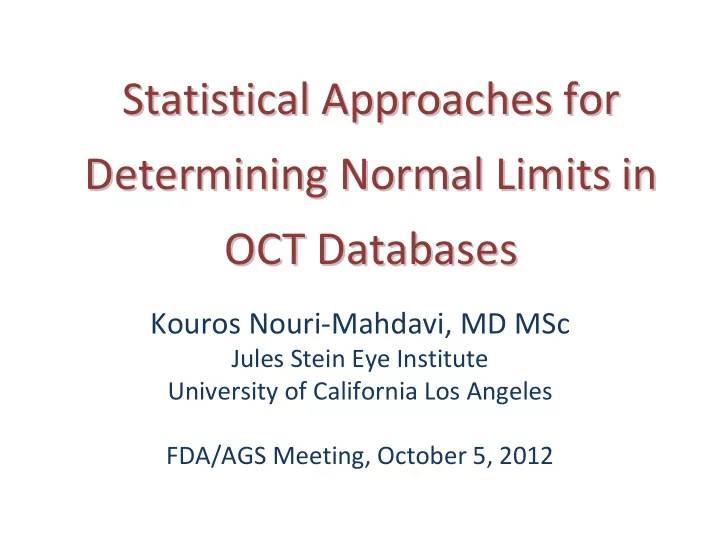

Statistical Approaches for Statistical Approaches for Determining Normal Limits in Determining Normal Limits in OCT Databases OCT Databases Kouros Nouri ‐ Mahdavi, MD MSc Jules Stein Eye Institute University of California Los Angeles FDA/AGS Meeting, October 5, 2012
Disclaimer and Acknowledgment Disclaimer and Acknowledgment • No financial interest with regard to any OCT devices. • Special thanks to Jeff Gornbein, DrPH, UCLA SBCC, for statistical advice and discussion
Detection of Disease Detection of Disease • Definition of “normal” • Choice of the sample • Sample size • Composition of the normative database • Covariates: to adjust or not to adjust
Definition of “ “Non Non ‐ ‐ Diseased Diseased” ” for Definition of for Inclusion in Normative Databases Inclusion in Normative Databases • No best criteria, normal IOP and achromatic visual fields commonly used • Including only eyes with normal discs leads to “supernormal” normative database • No requirement for a ‘normal’ disc > lower sensitivity for “preperimetric” glaucoma, not a big issue with Gaussian assumption
Current normative databases assume Gaussian distribution Nonparametric estimation methods more robust but need higher sample sizes Structural outcome − 2.326 SD = 1% cutoff − 1.645 SD = 5% cutoff SD units
Sampling and Sample Size Sampling and Sample Size • Convenience sampling customary • Potential for selection bias – An issue for defining prediction intervals (PIs) – Less problematic when evaluating correlations or predictors of structural outcomes • Distribution of predictive factors needs to be similar to ratios in the population for PIs but not as essential for correlations
Sampling Issues Sampling Issues • An effect of a small sample size is lack of precision for the 5% and 1% cutoff levels • Does it matter clinically? • Prediction limits generally wider for regional vs. global measures and for 1% vs. 5% cutoff
Precision of cutoff points is a function of Precision of cutoff points is a function of the sample size the sample size n lower 5th ptile upper width of 95% CI in SD units 10 2.911 1.645 1.017 1.894 15 2.566 1.645 1.114 1.452 20 2.396 1.645 1.175 1.221 25 2.292 1.645 1.217 1.075 30 2.22 1.645 1.25 0.970 35 2.167 1.645 1.276 0.891 40 2.125 1.645 1.297 0.828 50 2.065 1.645 1.329 0.736 60 2.022 1.645 1.354 0.668 120 1.899 1.645 1.433 0.466 240 1.819 1.645 1.492 0.327 480 1.766 1.645 1.535 0.231 inf 1.645 1.645 1.645 0 − 5th percentile estimate = mean − 1.645 SD 5th percentile estimate = mean 1.645 SD Table courtesy of Jeff Gornbein DrPH
Statistical cutoff points are Statistical cutoff points are artificial artificial • Abnormality or disease defined by purely statistical means (i.e., 95% PIs, etc.) are arbitrary – Functional definition of abnormality? – Potentially limited by the high variability of SF relationship Wollstein et al. BJO 2010
Multiple comparisons can lead to false Multiple comparisons can lead to false statistical ‘ ‘flagging flagging’ ’ statistical • More problematic with borderline findings and r =0.30 r =0.30 lower correlation • Prediction spaces for multiple correlated variables A bivariate normal 99% prediction ellipse A bivariate normal 99% prediction ellipse
Role of Covariates Role of Covariates • Covariate adjustment vs. stratification • Stratification is preferred: – When stratum in infrequent in the population – When interested in the performance of the test in particular strata • Types of covariates – Affecting distribution of structural outcomes – Associated with potentially ‘worse’ outcomes
Covariates Affecting Distribution of Covariates Affecting Distribution of Outcomes of Interest Outcomes of Interest • Gender? – GC/IPL, Mwanza et al. 2011, Koh et al. 2012; not with GCC, Kim et al. 2011 • Race – Is its influence a function of other anatomical factors? – Probably best to stratify for race with adequate sample size; but, assuming normal distribution, we can use mean and SD from smaller sample to adjust. • Disc size, shape, and position in relation to fovea • Signal strength
Covariates Potentially Associated with Covariates Potentially Associated with ‘Worse Worse’ ’ Structural Outcomes ‘ Structural Outcomes Need to adjust for? To what extent? • Age – Databases limited to age ≥ 18 – Commonly small number of subjects >70 yrs – exclude older subjects, i.e. >70 ‐ 75 years? • Refractive error? • Axial length? Budenz et al. Ophthalmology 2007
Distribution of RNFL Thinning in Myopia Distribution of RNFL Thinning in Myopia Leung CK et al. IOVS 2012
Role of Covariates Role of Covariates • Adjusted or stratified prediction intervals may potentially improve the precision of prediction intervals • Sliding scale significance levels? • Use of mathematical modeling for better prediction limits?
Non ‐ ‐ Statistical Issues Affecting Normative Statistical Issues Affecting Normative Non Databases Databases • Operator ‐ related (minimal with SD ‐ OCT) • Anatomical – Disc shape and size – Disc location in relation to fovea (fovea ‐ disc axis) – Location and angle of major vessels (10 ‐ 15% of RNFL thickness) • Image quality – Quality of media – Number of A ‐ scans (256 ‐ 1536) – Repetition rate (noise reduction) – Placement of the measurement circle – Tracking (reduces motion artifacts) • Segmentation algorithms • Optical magnification issues
THANK YOU THANK YOU
Recommend
More recommend